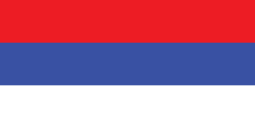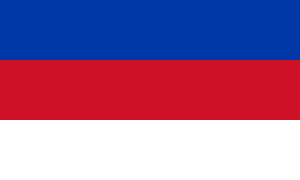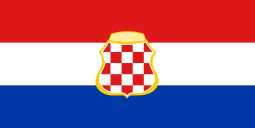Pan-Slavic colors
The Pan-Slavic colors (or colours) — red, blue and white — were defined by the Prague Slavic Congress, 1848, based on the flag of Russia, which was introduced in the late 17th century. The tricolor flag of Russia was itself inspired by the flag of the Netherlands.[1] Historically, many Slavic nations and states adopted flags and other national symbols that used some combination of those three colors. List of Slavic countries that use or have used the colors include: Russia, Yugoslavia,[2] Czechoslovakia,[3] Czech Republic,[3] Montenegro, Slovakia,[4] Croatia,[4] Serbia[4] and Slovenia.[4] On the other hand, Belarus, Bulgaria, North Macedonia, Poland and Ukraine have never adopted the colors. (The Flag of Poland is red and white, but has different roots that pre-date the pan-Slavic colors.)
.svg.png)
Yugoslavia, both the Kingdom (Kingdom of Yugoslavia, 1918–1943) and the Republic (SFR Yugoslavia, 1943–1992) was a union of several Slavic nations, and therefore not only sported the pan-Slavic colors but adopted the pan-Slavic flag as its own (later adding a red star). The later Federal Republic of Yugoslavia (1992–2003); a federation of Serbia and Montenegro, and its successor state, the State Union of Serbia and Montenegro (2003–2006) also used the pan-Slavic flag until the final dissolution of Yugoslavia in 2006. Serbia continues to use a flag with all three Pan-Slavic colors, along with Russia, Croatia, Slovakia and Slovenia.
The flag of Slovenia was introduced in 1848, when a group of Slovenian intellectuals in Vienna, Austria created the tricolor flag (white-blue-red). Slovakia also has the same tricolor flag design as Slovenia and Russia. The first Slovak flag was also introduced in 1848.
Examples of flags with Pan-Slavic colors
- Current countries






- Former countries
.svg.png)


.svg.png)
.svg.png)
%3B_Flag_of_Serbia_and_Montenegro_(2003%E2%80%932006).svg.png)
- Other entities

.svg.png)



See also
- Nordic Cross flag
- Pan-Arab colors
- Pan-African colours
- Pan-Slavism
- National colours of the Czech Republic
References
- Gabriella Elgenius (2007). Thomas Hylland Eriksen (ed.). Flag, Nation and Symbolism in Europe and America. Richard Jenkins. Routledge. p. 27. ISBN 978-1-134-06696-4. Retrieved 30 November 2015.
- The Encyclopedia Americana, Volume 11. Americana Corporation. 1972. p. 357. ISBN 9780717201044.
- Flag Wars and Stone Saints: How the Bohemian Lands Became Czech. Harvard University Press. 2007. p. 135. ISBN 0674025822.
- Shelley, Fred M. (2013). Nation Shapes: The Story behind the World's Borders. ABC-CLIO. pp. xvi. ISBN 9781610691062.
- Crampton, William G (1997). Flags. Dorling Kindersley Publishing, DK Publishing. ISBN 0789442248.
- Kamath, Anjali. Flag Book. Popular Prakashan. p. 27. ISBN 9788179915127.
- Bulletin on Constitutional Case-law. Secretariat of the Venice Commission. 2007. p. 395.
- De facto independent, but recognized de jure as part of the Republic of Moldova.
- Znamierowski, Alfred (2003). Illustrated Book of Flags. Southwater. p. 237.
- "Academy of Rusyn Culture in the Slovak Republic: Rusyn Symbols".